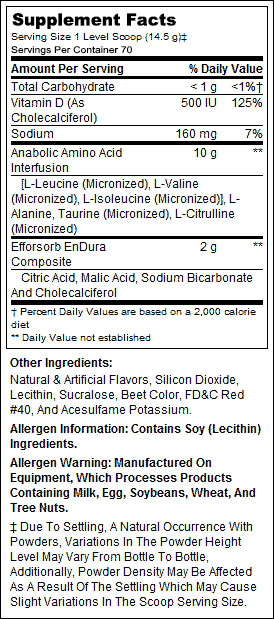Power Eating


How to Read a Nutrition Label
Be sure to read your labels carefully. Are the ingredients simple to read? Are they all disclosed? Or is the list of ingredients too long to count and too hard to pronounce? Do you know who made your product and what the level of quality is for the manufacture? If you can’t answer these questions, you could be getting a product that’s not living up to your expectations or its label claims. Not sure how to dissect that side panel to truly understand what’s in your favourite supplements, and if it’s time to start shopping for a new one? Keep reading for your very own how-to guide to understanding the nutrition facts label.
What Exactly Is a Nutrition Facts Label?
The nutrition facts label provides all the information you need to make an informed decision when it comes to your nutritional needs. This panel, located on the back of a product, provides information on 14 different nutrients, including the calories, fat (saturated and trans fat), cholesterol, protein, carbs, sugar, and fibres, along with key vitamins and minerals including vitamin A, C, calcium, and iron. This panel will also provide the percentage daily value of each nutrient based on government standard recommendations for a healthy diet of 2,000 calories. Protein powders, bars, ready-to-drinks, and vegetable and fruit powders all use nutrition facts panels, while products such as pills and pre-workout powders use supplement fact panels.
 How Much Protein?
How Much Protein?
Perhaps one of the most common nutrition facts labels you will scan is your protein powder. And the first thing you should check is the number of grams of protein per serving. The amount of protein should be a minimum of 80 percent of the serving size or more, depending on the type of protein and the other ingredients that may be found in the product. For example, whey proteins have a higher percentage of protein per volume than, say, soy protein. Additionally, whey protein isolate will be higher than whey concentrate. If your protein is less than 80 percent by weight, you might want to check what other ingredients are being added to bump up the scoop size—for example, inexpensive fillers such as maltodextrin or cheaper proteins or nonessential aminos.
What Else Is in it?
When you scroll down a nutrition facts label, the ingredients in the product must be ordered from most to least abundant. This allows for side-to-side comparison of ingredients between similar products. One key way to identify if your protein is of high quality is to see which proteins are listed in which order. If the cheaper proteins such as concentrates are above the higher quality proteins such as isolate, then you know the quality of the protein might not be up to your expectations. Additionally, you need to pay attention to what else is in the product and where these ingredients are located in the list of priorities. Is the product adding carbohydrate filler ingredients or trying to hide other ingredients by using fancy names? Often, companies will use the chemical names and fancy adjectives to describe common ingredients. For example, 1,3,7-trimethylpurine-2,6-dione is actually the chemical name for caffeine! Common microfractions found in all dairy proteins such as alpha-lactalbumin, beta-lactoglobulin, and lactoferrin are sometimes listed on the label even though they aren’t added separately. Be aware of these little tricks supplement companies use to try to fool you into thinking you’re getting something new, different, or better!

Is It Worth Your Money?
If you want to be sure the product you purchased is worth the money you paid for it—or are going to pay for it—you need to be sure that what’s in the product is only what’s listed on the bottle. When in doubt, don’t purchase products that contain proprietary blends. Proprietary blends are a way for cheap manufacturers to hide minuscule amounts of actives just to get the “hot” or “trendy” ingredient on the label panel, or to hide filler ingredients that can take up space, increasing scoop size and making you none the wiser. Instead purchase products that are transparent about the ingredients chosen and the amounts used.
Zero proprietary blend formulas allow for fair label comparison of most pill and powder products, but when it comes to protein powder, you might want to use a simple calculation. Multiple the number of servings by the amount of protein per serving in grams to give you an indication of how much protein is actually found in the product. Once you have this number, compare it to the gram weight of the product. Is there at least 80 to 85 percent protein in the product? If there is, you’ll know you have a pure product. Remember, if you’re purchasing powder products other than protein powder, such as weight gainer, a post-workout recovery supplement, or meal replacement powder, this number could be less and should be taken up by other ingredients such as carbohydrates powders, vitamins, minerals, or amino acids and other muscle-building nutrients.

Who Manufactured the Product?
High quality and trusted products are not afraid to tell you where they’re made or what their standards are. Although you may think most companies manufacture their own products, this isn’t the case. Many outsource their formulas to third-party manufacturers to develop, produce, and distribute. This process can result in a loss of formula control, added extras that you may not want, and added costs that get passed on to you. Check the label to see where or who is manufacturing and distributing the product, and that their standards are high! Look for the cGMP logo, which means they’re following good manufacturing procedures, or ISO, which means they’re using international organization for standardization of their manufacturing procedures.
For more about what COULD and SHOULD be in your supplements, specifically protein, check out our article about amino spiking here!

